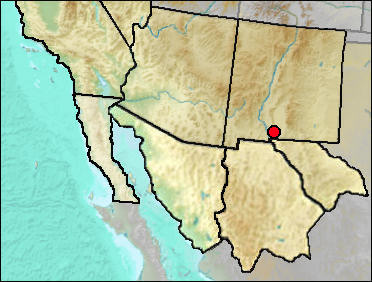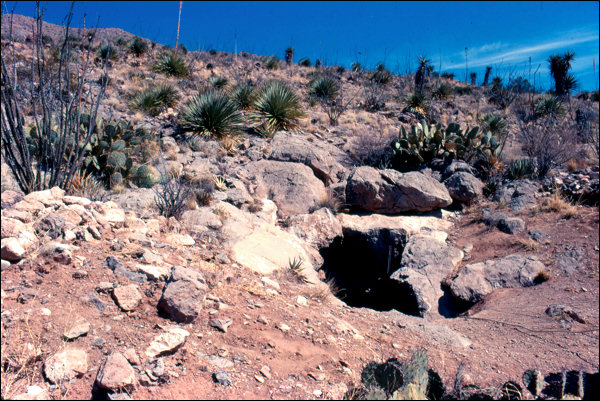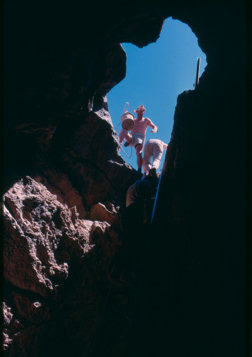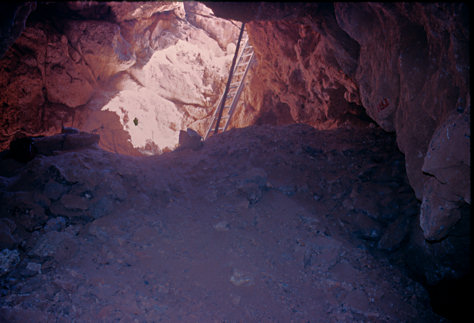 Age. Late Wisconsin/Holocene. Much of the
fauna clearly is Pleistocene, but upper portions of the cave fill include Holocene
plant material and almost certainly some Holocene faunal elements.
Age. Late Wisconsin/Holocene. Much of the
fauna clearly is Pleistocene, but upper portions of the cave fill include Holocene
plant material and almost certainly some Holocene faunal elements.
Synonyms. Bishop's Cap Cavern.
Discussion. "In the summer of 1929, Mr. J. W. Lytle, Mr. H. A. Wylde and Mr. W. L. Bliss excavated a cavern on the east slope of the Organ Mountains, in Dona Ana County, New Mexico" (Howard 1931:206). Howard also mentions that the cave was named in honor of Mr. Roscoe P. Conkling as the discoverer. The cave is on the eastern side of Bishops Cap, a southern limestone outlier of the Organ Mountains.

A vertical section (from a museum model) is shown in Conkling (1932). He mentions that the cavern was filled completely to within about 8 ft. "from the chimney-like neck at the entrance" and "Examination of the cave deposit indicates that some of the material is of the nature of wind-blown dune sand redeposited in old river beds"(p. 11). In his list, he has fresh water shells and some plant material (root of Algaroba or Mesquite tree; plant leaves; branch of Sotol Plant).
Fig. 1. Entrance to Conkling Cavern. Photograph by John Green.
Much of the faunal material certainly is Pleistocene in age, and presence of human remains (Stock 1931; Stewart 1952) indicate that the age to at least to considerable depth is late Wisconsin.
Conkling (1932) was a layman interested in cave faunas (and the discoverer of
several sites). As an untrained paleontologist, his publication leaves much to be
desired; a fair degree of subjectivity is involved in interpreting taxonomic records.
He listed mammalian taxa from a preliminary list complied by Chester Stock. I have
considerable reservations about the records of Megalonyx and "Possibly
Mylodon", but have listed them as given. Although he did not name Arctodus
 as the bear present, his description of it as a short-faced bear most
closely related to the Spectacled Bear of South America leaves little doubt as to what
was meant. Bison was represented by only one tooth, and it is possible that it
represents a different large bovid. Dire Wolf (Canis dirus) was noted as
occurring within the "Wolf Den" with gnawed horse, camel, and human bones.
Several species not present in Conkling's list are, however, recorded as present in
his discussion of various groups. Although only Antilocapra is mentioned in his
list, he names and accurately describes Capromeryx in the family account and
does not mention Antilocapra. Snake vertebrae and two plastrons of large turtles
are mentioned without any further identification.
as the bear present, his description of it as a short-faced bear most
closely related to the Spectacled Bear of South America leaves little doubt as to what
was meant. Bison was represented by only one tooth, and it is possible that it
represents a different large bovid. Dire Wolf (Canis dirus) was noted as
occurring within the "Wolf Den" with gnawed horse, camel, and human bones.
Several species not present in Conkling's list are, however, recorded as present in
his discussion of various groups. Although only Antilocapra is mentioned in his
list, he names and accurately describes Capromeryx in the family account and
does not mention Antilocapra. Snake vertebrae and two plastrons of large turtles
are mentioned without any further identification.
Fig. 2. Looking up at the entrance of Conkling Cavern from the landing at the bottom of the shaft. Photograph by John Green.
In comparing Conkling Cavern and Shelter Cave, there is a suggestion of differences in faunal ages in that great numbers of Coragyps occidentalis (47 specimens according to Conkling 1932) were present in Conkling Cavern while Cathartes aura is scarce (one specimen according to Conkling 1932), while the first was absent and the second abundant in Shelter Cave. At least in the Guadalupe Mountain region, Cathartes aura is rare or absent until near the end of the Pleistocene.

Brattstrom (1964) listed Tetrameryx as having been recovered from Conkling Cavern. However, this appears to be a misinterpretation either of Conkling's (1932) discussion of Capromeryx or of an unclear statement by Stock (1930).
Fig. 3. View back toward the bottom of the entrance shaft. Photograph by John Green.
Occurrence of Gopherus morafkai is based on Brattstrom's (1961:551) statement that "Fragments of shell from this cave are similar to G. agassizii."
The basis for the inclusion of Tamias and Spilogale in the faunal list as reported by Harris (1993c) appears to be undocumented and the taxa are withdrawn pending further investigation.
Fauna.
Amphibia
Ambystoma mavortium—Barred Tiger Salamander (UTEP)
Anaxyrus sp.—Bufonid Toad (UTEP)
Chelonia
Gopherus morafkai—Morafka's Tortoise (Brattstrom 1961).
Reptilia
Arizona elegans—Eastern Glossy Snake (Harris 1993c)
Almost certainly Holocene (hair in internal parts strongly suggest recent owl pellet material)
Masticophis sp.—Coachwhip Snake (Harris 1993c)
Rhinocheilus lecontei—Long-nosed Snake (Harris 1993c)
Crotalus sp.—Rattlesnake (UTEP)
Aves
Branta canadensis—Canada Goose (Howard and Miller 1933)
Callipepla gambelii—Gambel's Quail (Harris 1993c: ?)
Cathartes aura—Turkey Vulture (Howard and Miller 1933)
†Coragyps occidentalis—Western Vulture (Howard and Miller
1933)
Gymnogyps californianus—California Condor (Howard and Miller 1933)
Buteo swainsoni—Swainson's Hawk (Howard and Miller 1933)
Haliaeetus leucocephalus—Bald Eagle (Howard and Miller 1933)
Aquila chrysaetos—Golden Eagle (Howard and Miller 1933)
Caracara cheriway—Crested Caracara (Howard and Miller 1933)
Falco sparverius—American Kestrel (Howard and Miller 1933)
Centrocercus urophasianus—Greater Sagebrush-grouse (Howard and Miller
1933)
Callipepla sp.—Crested Quail (Howard and Miller 1933)
Meleagris gallopavo—Wild Turkey (Howard and Miller 1933; Rea 1980)
Geococcyx californianus conklingi—Conkling's Roadrunner (Howard 1931a;
Howard and Miller 1933)
Athene cunicularia—Burrowing Owl (Howard and Miller 1933)
Asio otus—Long-eared Owl (Howard and Miller 1933: ?)
Colaptes auratus—Northern Flicker (Howard and Miller 1933)
Eremophila alpestris—Horned Lark (Howard and Miller 1933)
Corvus corax—Common Raven (Howard and Miller 1933)
Gymnorhinus cyanocephalus—Pinyon Jay (Howard and Miller 1933)
Turdus migratorius—American Robin (Howard and Miller 1933)
Sialia sp.—Bluebirds (Howard and Miller 1933)
Agelaius phoeniceus—Red-winged Blackbird (Howard and Miller 1933: ?)
Carpodacus mexicanus—House Finch (Howard and Miller 1933)
Pipilo maculatus—Spotted Towhee (Howard and Miller 1933)
Mammalia
†Megalonyx sp.—Megalonyx Ground Sloth (Conkling 1932)
†Nothrotheriops shastensis—Shasta Ground Sloth (Conkling 1932
†Paramylodon sp.—Mylodontid Ground Sloth (Conkling 1932)
Homo sapiens—Man (Stock 1931)
Cynomys ludovicianus—Black-tailed Prairie Dog (Harris 1993c: cf.)
Otospermophilus variegatus—Rock Squirrel (UTEP)
Dipodomys spectabilis—Bannertail Kangaroo Rat (UTEP)
Thomomys bottae—Botta's Pocket Gopher (Harris 1993c)
Geomys sp.—Geomys Pocket Gopher (Harris 1993c)
Microtus mogollonensis—Mogollon Vole (Smartt 1977)
Neotoma cinerea—Bushy-tailed Woodrat (Harris 1993c)
Neotoma leucodon—White-toothed Woodrat (Harris 1993c)
Peromyscus sp.—White-footed Mouse (Harris 1993c)
Lepus townsendii—White-tailed Jackrabbit (UTEP: cf))
Sylvilagus audubonii—Desert Cottontail (Harris 1993c)
Sylvilagus nuttallii—Mountain Cottontail (Harris 1993c)
Antrozous pallidus—Pallid Bat (UTEP)
Myotis sp.—Myotis Bat UTEP)
Canis dirus—Dire Wolf (Nowak 1979)
Canis lupus—Gray Wolf (Conkling 1932)
Canis latrans—Coyote (Conkling 1932)
Vulpes macrotis—Kit Fox (Conkling 1932)
Urocyon sp.—Gray Fox (Harris 1993c)
Bassariscus sp.—Ringtail (Harris 1993c)
Arctodus simus—Short-faced Bear (Conkling 1932)
Mustela sp.—Weasel (Conkling 1932)
Mephitis mephitis—Striped Skunk (Conkling 1932)
Taxidea taxus—American Badger (Conkling 1932)
Puma concolor—Mountain Lion (Conkling 1932)
Lynx rufus—Bobcat (Conkling 1932: cf.)
Equus conversidens—Mexican Horse (Harris data)
Equus scotti—Scott's Horse (Harris data)
†Hemiauchenia sp.—American Llama (Harris 1993c)
†Camelops hesternus— (Conkling 1932)
Antilocapra sp. Pronghorn (Conkling 1932)
†Capromeryx sp.—Miniature Pronghorn (Conkling 1932)
Bison sp.—Bison (Harris 1993c)
Literature. Brattstrom 1961, ; Bryan 1929; Conkling 1932; Harris 1985a, 1993c; Howard 1931a, 1968; Howard and Miller 1933; Nowak 1979; Rea 1980; Smartt 1977; Stewart 1952; Stock 1931; Van Devender et al. 1976.
Last Update: 19 Feb 2015